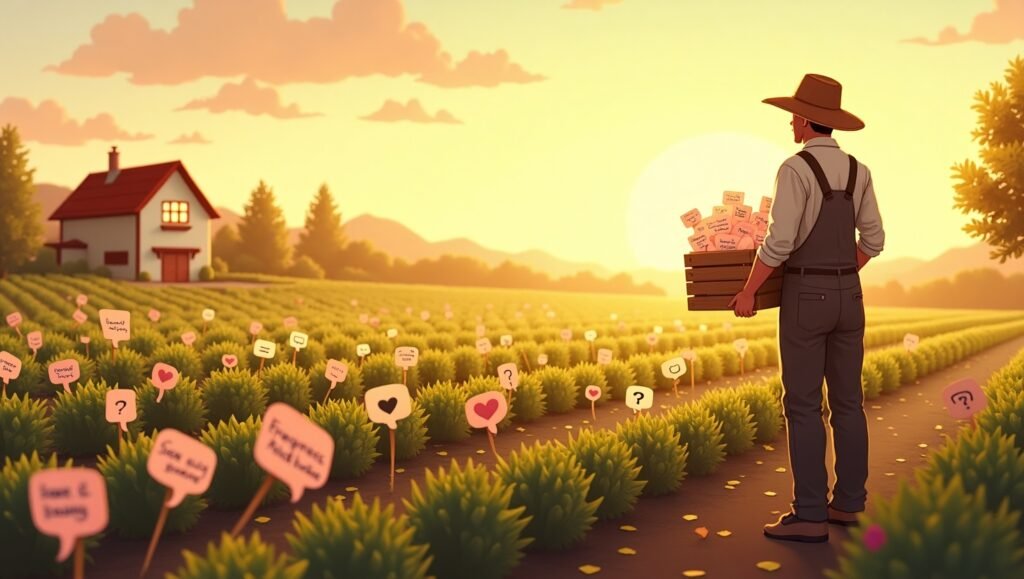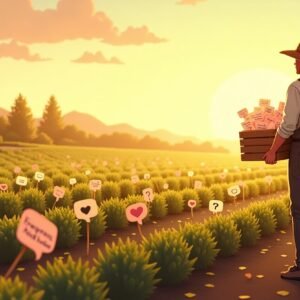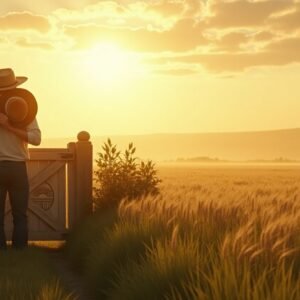
Direct Moi | Harvesting Trust – A Farmer’s Tale of Growing Customer Care
Hello and welcome to Direct Moi.
The sun hung low over the golden hills as the farmer stood at the edge of his land, gazing over fields that once were barren but now bloomed with promise. His crops swayed gently in the evening breeze—a beautiful sight born from years of toil, vision, and grit. He had cultivated his brand like his soil: patiently, purposefully, and with a heart full of dreams.
The fields had flourished. His produce was ripening under the careful gaze of the seasons. Word had spread of the farmer’s delicious harvests—apples that crunched with morning dew, herbs as fragrant as memory itself, and grain that turned to gold in the mill. But amid the scent of rain and the rustling leaves, something tugged at the edges of his contentment.
He had tilled his land, chosen his seeds, branded his farmstand with care, and welcomed curious passersby into his world. But now, as more buyers came, more questions followed. A crate had arrived bruised. A bundle of herbs was missing from a customer’s order. Someone needed help understanding how to preserve the jam they had bought.
And that’s when it dawned on him—his farm had grown, but his ability to care for those who supported it had not kept pace.
He had no shed where questions could be gathered, no designated row where concerns could be tended. There was no clear path for people to speak with him when things went wrong—or even just when they needed guidance.
This wasn’t just about fixing problems.
It was about nurturing trust.
It was about making people feel seen, heard, and respected—long after the transaction, like a letter arriving long after the harvest, reminding folks that they mattered.
So, the farmer paused his daily rhythms. The hoe was set down. The seed catalog was closed. He sat beneath the old oak tree near the brook, notebook in hand, and began to design a new part of the farm—not in the soil, but in the heart of his operations.
He called it: Customer Care Row.
In his mind’s eye, he began planting the first seeds of what would grow into his customer support system. He sketched a map: pathways for people to approach him, signs to guide them, baskets to collect their questions.
First, he asked himself, “How would people reach out?”
He imagined his customers arriving at the farm gate. Some came in person—neighbors and locals who wanted face-to-face reassurance. Others came from far beyond the hills, writing letters, sending notes by courier, or calling at dusk. In today’s world, these visits translated to emails, messages, live chat windows.
He decided that his farm would have three gates: one for email, one for live chat, and one—just for now—for written messages submitted through his website. Each gate would be manned by someone warm and understanding, trained not just to solve, but to listen.
Then, he thought of the FAQs—the Frequently Asked Fields, as he chuckled to himself.
He began to gather the questions he’d heard again and again. How long does the jam last? How do I prepare your dried herbs? Can I return a crate if the apples are bruised?
He imagined a wooden kiosk at the front of the farm with hand-carved plaques answering all these queries. Digitally, this would be a Help Center—organized, friendly, searchable.
Next, the farmer explored the tools that would help him manage this new system. Like choosing the right plough for rocky soil, he evaluated customer support tools with care. He tested ticketing systems that could track requests like seedlings in rows—each labeled, monitored, and tended until resolved.
He explored platforms that offered CRM tools, helping him remember each visitor’s story. Who had returned after a bad season? Who had placed a large order last year and might do so again? These tools would help him keep relationships alive, just as he remembered which soil patch needed extra compost.
But beyond the systems and signs, the farmer knew the most important element was tone. No automation, no software, no checklist could replace the human warmth needed to assure someone their concerns mattered.
So, he wrote a simple motto for his team:
“Respond like you’re talking to your favorite neighbor.”
He trained his helpers not only in logistics but in empathy—how to listen without rushing, how to speak with clarity and care, and how to leave someone feeling better than they arrived.
And still, the farmer wasn’t done. He knew that in any relationship, it’s not just about being there in the moment—it’s about following up. After a problem was resolved, a message would be sent: “How was your experience? Can we do more?” A gentle nudge, like checking if a sapling has taken root.
As weeks passed, the new system took shape.
Visitors felt heard. Problems were resolved swiftly. Confusion turned to clarity. And the farmer began to notice something—more than gratitude, more than thanks.
Loyalty.
People returned. Not just for the products, but for the way they felt when they engaged with the brand. Word spread, like stories shared around a fire—of a farmer who not only grew things, but cared deeply about the people he served.
Still, the farmer knew that a farm was never finished.
He created a habit—every moon cycle, he reviewed feedback, harvesting insights from what people shared. If questions repeated too often, he adjusted the FAQ. If problems persisted, he improved his processes—or even the product.
Customer care, he realized, was not a patch of land to be ploughed once and left. It was a living garden, always evolving. He introduced new tools as the farm grew. He automated routine responses to free time for deeper conversations. He updated his help desk as more channels opened.
He even began to track patterns—what days saw the most queries? Which products raised the most questions? From this, he planted improvements upstream, solving problems before they even reached the gate.
But most importantly, he never lost sight of the philosophy that bloomed beneath it all:
That customer support isn’t a department. It’s a spirit.
It wasn’t confined to the row he built or the helpers he trained. It was in the way he wrote his packaging notes. In the care with which he labeled his jars. In the honesty of his delivery updates, even when delays happened.
It was in the soil of his brand.
And as storms came—as they always do in business and in life—the farmer found that this row he had built, this system of care, became a shelter. Even in difficult times, customers stood by him. They knew that while harvests might vary, they would always be treated with dignity.
So the farmer stood once again at the edge of his land, now not just golden with grain but rich with relationships. He smiled—not because all was perfect, but because he knew he had built something deeper than a business.
He had built trust.
And as the wind danced through the fields, he whispered a quiet truth to the horizon:
“The harvest may feed them,
but it’s the care that keeps them coming home.
Thank you for listening to this journey of building customer support, the farmer’s way. If this story planted a seed in your heart, like, share, comment, or pass it along to someone building their own field of dreams. Until next time—stay rooted, stay kind, and keep growing. 🌾








2 Comments